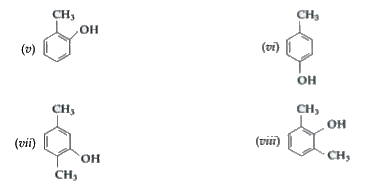Alcohols are phenols consist of two parts, an alkyl/aryl group and a hydroxyl group. The properties of alcohols and phenols are chiefly due to the hydroxyl group. The nature of alkyl and aryl groups simply modify these properties.
The boiling points of alcuhols and phenols increase with increase in the number of carbun atoms (increase in van der Waals forces). In alcohols, the builing points decrease with increase of branching in carbon chain (because of decrease in van der Waals forces with decrease in surface area). The group in alcohols and phenols is involved in intermolecular hydrogen bonding.
It is interesting to note that boiling points of alcohols and phenols are higher in compariscn to other classes of compounds, namely hydrocarbons, ethers, haloalkanes and heloarenes of comparable molecular masses. For example, ethanol and propane have comparable molecular masses but their boiling points differ widely. The boiling point of methoxymethane is intermediate of the two boiling points. The high boiling points of alcohols are mainly due to the presence of intermolecular hydrogen bonding in them which is lacking in ethers and hydrocarbons.
Why do branched alcohols show a smaller boiling points than straight chain alcohols ?
Branched molecules have smaller area of contact and smaller van der Waals forces of attraction and hence smaller boiling points.
Topper's Solved these Questions
- ALCOHOLS, PHENOLS AND ETHERSBOOK - U-LIKE SERIESCHAPTER - ALCOHOLS, PHENOLS AND ETHERSEXERCISE - MULTIPLE CHOICE QUESTIONS
19 Videos
- ALCOHOLS, PHENOLS AND ETHERSBOOK - U-LIKE SERIESCHAPTER - ALCOHOLS, PHENOLS AND ETHERSEXERCISE - ASSERTION-REASON QUESTIONS
10 Videos
- ALCOHOLS, PHENOLS AND ETHERSBOOK - U-LIKE SERIESCHAPTER - ALCOHOLS, PHENOLS AND ETHERSEXERCISE - NCERT TEXTBOOK EXERCISES
30 Videos
- ALDEHYDES, KETONES AND CARBOXYLIC ACIDSBOOK - U-LIKE SERIESCHAPTER - ALDEHYDES, KETONES AND CARBOXYLIC ACIDSEXERCISE - SELF ASSESSMENT TEST (SECTION B)
1 Videos
Similar Questions
Resorcinol has the structure
View SolutionAssertion (A) : The catalyst used inFriedel Crafts reaction is anhydrous AlCl3.
Reason (R) : Anhydrous aluminium chloride is a Lewis acid.
View SolutionWrite IUPAC names of the following compounds :
((i) CH3−CH| CH3−CH| OH−CH3| C | CH3−CH3
(ii) CH3−CH| OH−CH2−CH| OH−CH| C2H5−CH2CH3
(iii) CH3−CH| OH−CH| OH−CH3
(iv) HO−CH2−CH| OH−CH2−OH

(ix) CH3−O−CH2−CH| CH3−CH3
(x) C6H5−O−C2H5
(xi) C6H5−O−C7H15(n−)
(xii) CH3−CH2−O−CH| CH3−CH2−CH3
View SolutionAn organic compound (A) has a characteristic colour, on treatment with NaOH, it forms compound (B) and (C ). Compound (B) has molecular formula C7H8O which on oxidation gives back (A). The compound (C ) is sodium salt of an acid. When (C ) is treated with sodalime, it yields on aromatic compound (D). Deduce the structures of (A), (B), (C ) and (D). Write the sequence of reactions involved.
View SolutionWhich is true acidic character of hydroxyl groups of sugars and hydroxyl group of an alcohol?
View SolutionDescribe the mechanism by which the hydroxyl group attached to an aromatic ring is more acidic than the hydroxyl group attached to the alkyl group. How does the presence of a nitro group in phenol affect its acidic nature ?
View SolutionAssertion : Solubility of alcohols in water decreases with the increase in the molecular mass.
Reason : The increase in the size of the alkyl group increases the polar nature of O−H group.
View Solutionहैलोऐल्केनस के क्वथनांक ऐल्किल समूह के आकार में वृध्दि के साथ बढ़ते है ।
View SolutionAssertion: Aryl halides cannot be prepared by replacement of hydroxyl group of phenol by halogen atom.
Reason: Phenols react with halogen acids violently.
View Solutionएथिल एलकोहॉल तथा फिनॉल दोनों में OH समूह उपस्थित रहता है| क्या कारण है की फिनॉल अम्लीय और एलकोहॉल उदासीन प्रकृति का होता है|
View SolutionAn amino acid with a phenolic hydroxyl group is
View Solutionएथिल ऐल्कोहॉल तथा फीनॉल दोनों में OH समूह उपस्थित रहता है। क्या कारण है कि फीनॉल अम्लीय और ऐल्कोहॉल उदासीन प्रकृति का होता है ?
View Solutionऐल्किल समूह बढ़ने पर ऐल्कोहॉल की विलयता पर क्या प्रभाव पड़ता है ?
View SolutionFor the same alkyl (or) aryl group, boiling point, is more for
View SolutionAssertion: Aryl halides cannot be prepared by replacement of hydroxyl group of phenol by halogen atom. Reason: Phenols react with halogen acids violently.
View Solution
